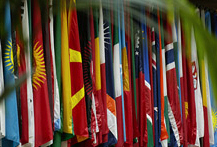
Typical street scene in Santa Ana, El Salvador. (Photo: iStock)
IMF Survey: Terms of IMF Lending Seen as More Focused, Better Tailored
September 17, 2012
- IMF has streamlined conditions for lending, better targeted on country programs
- Programs have generally been more effective and safeguarded priority spending
- Report highlights need for stronger country ownership, transparency
The IMF has largely learnt lessons from previous crises to improve the way it lends to countries in trouble and be better targeted and flexible, an internal review of lending “conditionality” finds.

The report suggests that the IMF should try to enhance country ownership and transparency of lending programs (photo: IMF)
Review of Conditionality
IMF-supported programs designed to help countries get out of economic difficulty have been generally better tailored to individual country needs. Programs have adapted flexibly to changing economic circumstances, which has helped to achieve program objectives, and have aimed to safeguard social protection and investment during crises.
The IMF had improved its analysis, internalizing lessons from previous crisis periods. For example, the overshooting current account adjustments seen in some programs of the 1990s have been mostly avoided this time around, and, where possible, ample and upfront financing to create room for maneuver was emphasized, particularly in capital account crisis cases.
But the review warned that the IMF faced new challenges, particularly in the current euro area crisis, where the size of the debt burdens, the systemic nature of the crisis, and the need for coordination across institutions made both forecasting and program design more complex.
“Program design has been complicated where countries faced high debt burdens, sustained loss of market access, low growth, and competitiveness issues, and where the constraints of a currency union limited policy options,” the report to the IMF Executive Board said.
“Debt sustainability and competitiveness problems required deep and protracted policy adjustment, combined with large-scale official financing,” it stated.
Wider policy options
The report suggested that the IMF should try to enhance country ownership and transparency of lending programs through more discussion of alternative policy options, greater clarity in written assessments, and by tapping new avenues to collect external views.
The social aspects of policy measures in program design needed to be considered in a broader context, it stated. Reforms often involve near-term costs yielding significant long-term benefits that should not be neglected in the analysis.
Recent experience in the Middle East, Northern Africa, and Europe highlighted the need for analysis to take into account employment issues and inclusive growth strategies.
Ongoing process
The latest review of IMF conditionality is part of a process of ongoing, periodic assessments of IMF-supported programs that is undertaken by the Executive Board and the IMF’s staff.
An IMF-supported program is a package of policy measures which, combined with approved financing, is intended to achieve orderly external adjustment and macroeconomic stabilization. Many programs also include growth and poverty reduction objectives.
Conditionality in IMF-supported programs aims to help countries solve their balance of payments problems while safeguarding IMF resources. In its broadest sense, conditionality covers both the design of IMF-supported programs and the specific tools used to monitor progress toward the goals outlined by the country in cooperation with the IMF.
The review, which focuses on the period 2002-September 2011—concentrating on programs approved after 2006— examines 159 IMF-supported programs, including 95 programs for poorer countries, often involving lending at very low interest rates (60 percent of the total), and 64 general lending programs.
Action taken already
The IMF has done a lot to improve its conditionality and lending programs based on past assessments. Improvements include
• Further efforts to streamline and focus conditionality, including following a report by the IMF’s Independent Evaluation Office in 2007 on structural conditionality.
• Discontinuation of structural performance criteria and a shift to review-based monitoring of structural reforms as part of the 2008-09 lending reforms.
• Reform of the exceptional access policy for loans and the introduction of the Flexible Credit Line (FCL) and Precautionary Credit Line (PCL) in 2009-10, which aimed at facilitating the provision of precautionary finance while tailoring conditionality to the strength of members’ fundamentals and policies.
• A new lending framework for low-income countries introduced in 2009, which doubled lending access norms, introduced new facilities (the Rapid Credit Facility and the Standby Credit Facility, and increased program flexibility.
Need to strengthen further
Overall, the review found that the IMF’s conditionality guidelines were broadly appropriate, but implementation of these and other policies needed strengthening. The paper presents results and recommendations organized around six themes:
• Keeping conditionality focused;
• Enhancing risk diagnostics underpinning program design;
• Considering macrosocial issues in IMF-supported programs;
• Enhancing program ownership and transparency;
• Leveraging economic surveillance to increase contingency planning; and
• Improving partnerships with other institutions.


